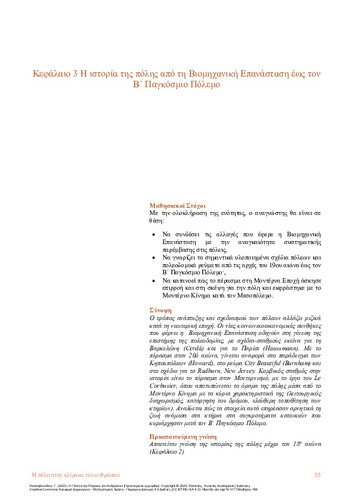| Title Details: | |
|
The history of the city from the Industrial Revolution to World War II |
|
| Authors: |
Katsavounidou, Garyfallia |
| Description: | |
| Abstract: |
The development and design of cities changes radically in the modern era. The Industrial Revolution brings about new social and economic conditions that lead to the birth of urban planning as a scientific field. Key plans of the 19th century are that of Barcelona (Cerdá) και of Paris (Haussmann). In the beginning of the 20th century, important movements are that of Garden Cities (Howard), City Beautiful (Burnham) and the Radburn model. In the interwar period, Le Corbusier’s manifesto of Modernism propagates its main attributes: separation of uses, annulment of the street, free-standing slabs and towers. These characteristics influence life between buildings in a negative manner, as soon as Modernism becomes a lived reality in the functionalistic postwar development around the world.
|
| Linguistic Editors: |
Triantari, Maria |
| Graphic Editors: |
Oikonomou, Evangelia |
| Type: |
Chapter |
| Creation Date: | 27-06-2023 |
| Item Details: | |
| License: |
Attribution - NonCommercial - ShareAlike 4.0 International (CC BY-NC-SA 4.0) |
| Handle | http://hdl.handle.net/11419/9836 |
| Bibliographic Reference: | Katsavounidou, G. (2023). The history of the city from the Industrial Revolution to World War II [Chapter]. In Katsavounidou, G. 2023. The City at Human Scale [Undergraduate textbook]. Kallipos, Open Academic Editions. https://hdl.handle.net/11419/9836 |
| Language: |
Greek |
| Is Part of: |
The City at Human Scale |

